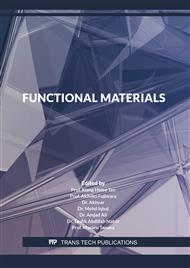p.73
p.79
p.85
p.91
p.99
p.107
p.113
p.121
p.131
Influence of Bending-Twisting Coupling Deformation on Pure Bending Strength and Fracture Morphology of CFRP Angle-Ply Laminate
Abstract:
The purpose of this study is to investigate the effect of bending-twisting coupling deformation on the bending strength of CFRP in which laminate configuration has symmetricity and angled fiber orientation. In this study, a novel type of test fixture for pure bending test that permit the coupled bending-twisting deformation is newly developed. Test results showed that the pure bending strength of the angle-ply laminates was decreased when bending-twisting coupled deformation was permitted. The normalized bending strength when the bending-twisting coupled deformation is permitted was decreased with increase of coupled component of angle-ply laminate. Observations of fracture morphology of specimen also showed that the specimen was firstly failure at the 0° layer on the compression side, no matter if the coupled deformation was permitted or constrained. However, when the coupled deformation was permitted, the failure was occurred at lower applied bending stress compared with when coupled deformation was constrained. Moreover, when the coupled deformation was permitted, the failure of 0° layer was occurred at the diagonal portion of specimen. These results suggested that the existing of in-plane shear stress at 0° layer affects the fracture morphology of specimen.
Info:
Periodical:
Pages:
99-105
Citation:
Online since:
August 2022
Authors:
Price:
Сopyright:
© 2022 Trans Tech Publications Ltd. All Rights Reserved
Share:
Citation:



